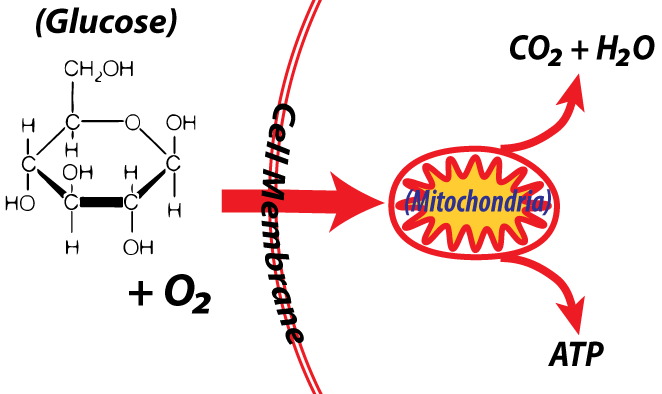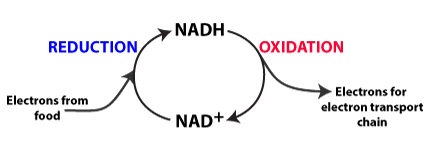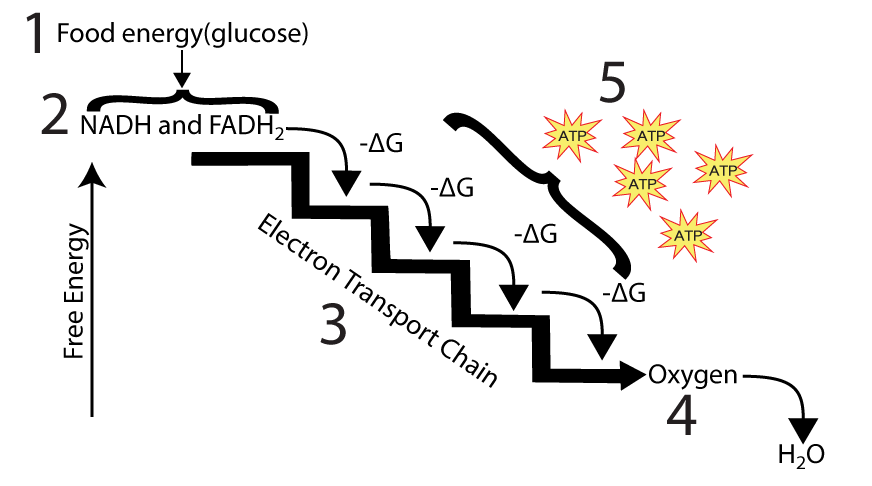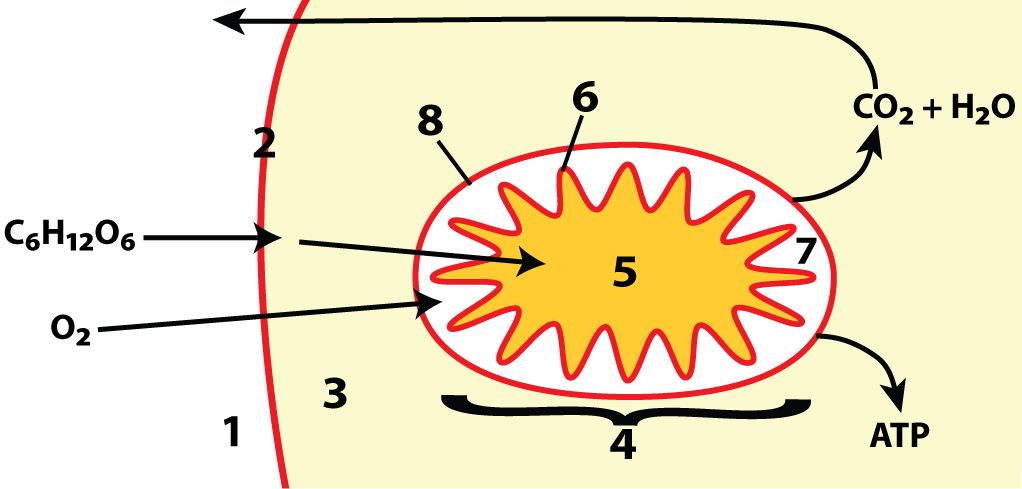1. Cellular respiration happens in the cytoplasm and the mitochondria
In previous tutorials in this module, we used this diagram to set cellular respiration in its cellular context.

Now let’s increase the level of detail.
Number “1” represents the cell’s exterior. The glucose (C6H12O6) shown outside the cell would come from food, which passes to your intestines, then diffuses into your blood, which delivers it to your cells. The oxygen (02) would come from the air, which is absorbed into your lungs, and then diffuses into your blood for delivery to your cells.
Number “2” represents the cell membrane. While oxygen easily diffuses through the membrane, the glucose requires special channels.
Enzymes in the cytoplasm (number “3”) begin the process of cellular respiration, partially breaking down glucose during a process called glycolysis. Glycolysis means “splitting sugar” and it produces a small amount of ATP. The products of glycolysis then diffuse into the mitochondria (at “4”).
Mitochondria (as we’ve discussed earlier) are essentially bacterial cells that live inside of our cells. They have an outer membrane (“8”) and a highly folded inner membrane (at “6”).
Within the inner membrane is the mitochondrial matrix (“5”). You can think of the matrix as the cytoplasm of the mitochondria. It contains the mitochondria’s own chromosome and ribosomes (not shown). It’s also packed with enzymes. These enzymes carry out a cycle of reactions called the Krebs cycle that completely break down what was left from the glucose that originally diffused into our cells.
The inner membrane is also packed with enzymes. These enzymes form what’s called the electron transport chain. This system uses the energy of flowing electrons to generate ATP from ADP and phosphate.
The area between the inner and outer membrane makes up a region called the intermembrane space (“7″). We’ll see below the role it plays in ATP creation.
Use the quiz below to consolidate what you just read.
[qwiz qrecord_id=”sciencemusicvideosMeister1961-Where Cellular Respiration Happens (HS)”]
[h]Where Cellular Respiration Happens
[i]
[q]Which number is the cell membrane?
[textentry single_char=”true”]
[c]wq Ay[Qq]
[f]IFllcywg4oCcMuKAnSBpcyB0aGXCoGNlbGwgbWVtYnJhbmU=[Qq]
[c]Kg==[Qq]
[f]Tm8uwqBUaGUgbWVtYnJhbmUgaXMgdGhlIGNlbGwmIzgyMTc7cyBvdXRlciBib3VuZGFyeS4gSWYgdGhlIGdsdWNvc2UgYW5kIG94eWdlbiAoQw==Ng==SA==MTI=Tw==[Qq]6 6O2) are outside the cell, and the cytoplasm is at “3,” then what number would be representing the membrane?
[q]Which number is the cytoplasm?
[textentry single_char=”true”]
[c]wq Az[Qq]
[f]IFllcywg4oCcM+KAnSBpcyB0aGXCoGN5dG9wbGFzbS4=[Qq]
[c]Kg==[Qq]
[f]Tm8uIFRoZSBjeXRvcGxhc20gaXMgdGhlIHJlZ2lvbiBiZXR3ZWVuIHRoZSBjZWxsJiM4MjE3O3MgbWVtYnJhbmUgYW5kIHRoZSBudWNsZXVzICh3aGljaCBpc24mIzgyMTc7dCBzaG93biBpbiB0aGlzIGRpYWdyYW0pLiBXaGljaCBudW1iZXIgaXMganVzdCBpbnNpZGUgdGhlIG1lbWJyYW5lIChidXQgbm90IHBhcnQgb2YgYW55IG90aGVyIHN0cnVjdHVyZSk/
Cg==[Qq]
[q]Which number is the mitochondrion?
[textentry single_char=”true”]
[c]wq A0[Qq]
[f]IFllcywg4oCcNOKAnSBpcyB0aGUgbWl0b2Nob25kcmlvbi4=[Qq]
[c]Kg==[Qq]
[f]Tm8uIExvb2sgZm9yIHRoZcKgY2VsbC1saWtlIG9yZ2FuZWxsZSBpbnNpZGUgdGhlIGN5dG9wbGFzbS4=
Cg==[Qq]
[q]Which number is the mitochondrial matrix?
[textentry single_char=”true”]
[c]ID U=[Qq]
[f]IFllcywg4oCcNeKAnSBpcyB0aGUgbWF0cml4Lg==[Qq]
[c]Kg==[Qq]
[f]Tm8uwqBUaGXCoG1hdHJpeCBpcyBhbmFsb2dvdXMgdG8gdGhlIGN5dG9wbGFzbSBvZiBhwqBtaXRvY2hvbmRyaW9uLiBJZiB0aGF0JiM4MjE3O3Mgbm90IGVub3VnaCBvZiBhIGhpbnQsIGl0JiM4MjE3O3MgdGhlIHJlZ2lvbiBpbnNpZGUgb2YgYcKgbWl0b2Nob25kcmlvbiYjODIxNztzIGlubmVyIG1lbWJyYW5lLg==
Cg==[Qq]
[q]Which number is the mitochondrial inner membrane?
[textentry single_char=”true”]
[c]wq A2[Qq]
[f]IFllcywg4oCcNuKAnSBpcyB0aGUgbWl0b2Nob25kcmlhbCBpbm5lciBtZW1icmFuZS4=[Qq]
[c]Kg==[Qq]
[f]Tm8uIFN0YXJ0IGJ5IGZpbmRpbmcgYSBtaXRvY2hvbmRyaW9uICh0aGUgc3RydWN0dXJlIHNob3duLCBpbiB0aGlzIGRpYWdyYW0sIGluc2lkZSB0aGUgY2VsbCkuIE5vdGUgdGhhdCBpdCBoYXMgdHdvIG1lbWJyYW5lcy4gVGhlIGlubmVyIG9uZSBpcyBoaWdobHkgZm9sZGVkLg==
Cg==[Qq]
[q]Which number is the intermembrane space?
[textentry single_char=”true”]
[c]wq A3[Qq]
[f]IFllcywg4oCcN+KAnSBpcyB0aGXCoGludGVybWVtYnJhbmUgc3BhY2Uu[Qq]
[c]Kg==[Qq]
[f]Tm8uwqBUaGUgaW50ZXJtZW1icmFuZSBzcGFjZSBpcyB0aGUgcmVnaW9uIG9mIGEgbWl0b2Nob25kcmlvbiBpbi1iZXR3ZWVuIHRoZSBpbm5lciBhbmQgb3V0ZXIgbWVtYnJhbmUuIElmIHRoZSBtaXRvY2hvbmRyaW9uIGl0c2VsZiBpcyBhdCAmIzgyMjA7NCwmIzgyMjE7IHRoZW4gd2hhdCBudW1iZXIgd291bGQgYmUgdGhlIGludGVybWVtYnJhbmUgc3BhY2U/
Cg==[Qq]
[q]Which number is the mitochondrial outer membrane?
[textentry single_char=”true”]
[c]wq A4[Qq]
[f]IFllcywg4oCcOOKAnSBpcyB0aGUgbWl0b2Nob25kcmlhbCBvdXRlciBtZW1icmFuZS4=[Qq]
[c]Kg==[Qq]
[f]Tm8uwqBUaGUgb3V0ZXIgbWl0b2Nob25kcmlhbCBtZW1icmFuZSBpc8KgdGhlIHNlbGVjdGl2ZWx5IHBlcm1lYWJsZSBiYXJyaWVyIHRoYXQgc2VwYXJhdGVzIHRoZSBtaXRvY2hvbmRyaW9uICgmIzgyMjA7NCYjODIyMTspIGZyb20gdGhlIGN5dG9wbGFzbSAoJiM4MjIwOzMmIzgyMjE7KS4gS2VlcGluZyBpbiBtaW5kIHRoZSBmYWN0IHRoYXQgbWl0b2Nob25kcmlhIGhhdmUgYSBkb3VibGUgbWVtYnJhbmUsIHdoaWNoIG51bWJlciBoYXMgdG8gYmUgdGhlIG91dGVyIG9uZT8=
Cg==[Qq]
[q]Which number is the outside of the cell?
[textentry single_char=”true”]
[c]wq Ax[Qq]
[f]IFllcywg4oCcMeKAnSBpcyB0aGUgb3V0c2lkZSBvZiB0aGUgY2VsbC4=[Qq]
[c]Kg==[Qq]
[f]Tm8uwqBUaGUgb3V0c2lkZSBvZiB0aGUgY2VsbCwgb3IgY2VsbCBleHRlcmlvciwgaXMgdGhlIHJlZ2lvbiBvdXRzaWRlIG9mIHRoZSBjZWxsJiM4MjE3O3MgbWVtYnJhbmUuIFdoYXQmIzgyMTc7cyBleHRlcmlvciB0byB0aGUgbWVtYnJhbmU/
Cg==[Qq]
[q]Glycolysis is the first stage of cellular respiration. It happens in region 3, called the [hangman]. After glycolysis, the next major phase of the respiration is the Krebs cycle, which happens in the mitochondrial [hangman], shown at 5. The electron transport chain happens at the mitochondrial [hangman] membrane, shown at 6.
[c]Y3l0b3BsYXNt[Qq]
[c]bWF0cml4[Qq]
[c]aW5uZXI=[Qq]
[/qwiz]
2. Cellular respiration oxidizes glucose to release energy to make ATP
In previous tutorials, we’ve compared what happens during the process of combustion (burning a fuel) to what happens in cellular respiration (converting the energy in food into the chemical energy of ATP).
While the two processes happen in very different ways, there are two important similarities.
- Both release energy.
- Both are oxidation-reduction reactions.

Oxidation means loss of electrons. Oxidation is always paired with a complementary process called reduction, which means gain of electrons.
Oxidation-reduction reactions happen all the time. Every time you light a match, or operate a gas stove, you’re involved with an oxidation-reduction reaction.
Let’s look at respiration as an oxidation-reduction reaction. Here’s the equation.
C6H12O6 + 6O2 –> 6CO2 + 6H2O + energy (in the form of ATP)
In respiration,
- Glucose is oxidized to carbon dioxide. Note that the oxidation of glucose involves the loss of hydrogen atoms. These hydrogens can be thought of as carrying electron energy. Compare glucose (C6H12O6 ) to six carbon dioxides (6CO2 ). Notice the missing 12 hydrogens.
- Oxygen is reduced to water. Note that this reduction involves the gain of hydrogen atoms. Compare the six oxygen molecules (6O2) to six water molecules (6H2O ). Notice the gain of 12 hydrogens.
While combustion involves a single-step, rapid oxidation of a fuel, respiration involves many intermediate steps. During respiration, enzymes oxidize glucose into smaller molecules with less energy. As glucose and its by-products get oxidized, electrons and hydrogens get transferred to mobile electron carriers.
Mobile electron carriers are like rechargeable batteries (but really small). As we’ll see, these mobile electron carriers, when they’re charged up, power the mitochondrial electron transport chain. The mitochondrial electron transport chain, in turn, powers the creation of ATP.
Here are the two mobile electron carriers that are involved in cellular respiration:
- NAD+ becomes reduced to form NADH.
- FAD becomes reduced to form FADH2.
 |
 |
Let’s push the analogy of NADH and FADH2 as rechargeable batteries a bit further When you place a charged battery into a device like a radio, the battery can create an electrical current. An electrical current is a flow of electrons that can be used to do some work (like taking a radio signal, amplifying it, and converting it into sound). NADH and FADH2 do a similar thing. They carry electron energy from either the cytoplasm or the mitochondrial matrix, and bring it to the inner mitochondrial membrane. Once there, they release their electrons to the electron transport chain. The electron transport chain uses this electron energy to create ATP.
Here’s another analogy that might help. If cellular respiration were a game of football and energetic electrons were the ball, then the end zone would be the inner membrane of the mitochondria (where the electron transport chain is found). NADH and FADH2 are like fullbacks: they carry the ball (the electrons) to the end zone.
We’ll learn the astounding details of how this ATP is generated in a later tutorial, but for now, study this diagram.

Number “1” represents the source of all the energy: food. NADH and FADH2 (at “2”) are mobile electron carriers: they bring energetic electron and hydrogens from the cell’s cytoplasm or the mitochondrial matrix to the electron transport chain, which is located in the inner membrane of the mitochondria. The electron transport chain is represented by the stairway at “3.” The enzymes that make up the electron transport chain use the energy in these electrons from food to set up the conditions for making ATP. At the end of the process, these electrons flow to oxygen, the final acceptor in the chain. As oxygen accepts electrons, it becomes reduced to form water.
To the right of the electron transport chain staircase, you can see several “-ΔG” symbols. Those symbols mean that energy is released. What for? To make ATP. We’ll see how in the next tutorials. But for now, take the quiz below to consolidate what you’ve learned above.
3. Cellular Respiration as Oxidation : checking understanding.
[qwiz qrecord_id=”sciencemusicvideosMeister1961-Respiration and Oxidation (HS)”]
[h] Cellular Respiration as Oxidation: checking understanding
[q]
[c]IHJlZHVjdGlvbg==[Qq]
[f]IEdvb2Qh[Qq]
[c]IG94aWRhdGlvbg==[Qq]
[f]IEdyZWF0IQ==[Qq]
[c]IGZvb2Q=[Qq]
[c]IGNoYWlu[Qq]
[q] Gain of electrons is called [hangman]. Loss of electrons is [hangman].
[c]IHJlZHVjdGlvbg==[Qq]
[f]IEdvb2Qh[Qq]
[c]IG94aWRhdGlvbg==[Qq]
[f]IENvcnJlY3Qh[Qq]
[q] During cellular respiration, the following reaction occurs
C6H12O6 + 6O2 –> 6CO2 + 6H2O + energy (in the form of ATP)
Glucose is [hangman] to carbon dioxide. You can tell because of the loss of [hangman] atoms. At the same time, [hangman] is reduced to water. The biological function of the reaction is to create the molecule [hangman], which the cell uses to do the work of staying alive.
[c]IG94aWRpemVk[Qq]
[f]IEV4Y2VsbGVudCE=[Qq]
[c]IGh5ZHJvZ2Vu[Qq]
[f]IEV4Y2VsbGVudCE=[Qq]
[c]IG94eWdlbg==[Qq]
[f]IEV4Y2VsbGVudCE=[Qq]
[c]IEFUUA==[Qq]
[f]IEdvb2Qh[Qq]
[q] Which process below occurs in the inner mitochondrial membrane?
[textentry single_char=”true”]
[c]ID M=[Qq]
[f]IFllcy4gdGhlIEVsZWN0cm9uIHRyYW5zcG9ydCBjaGFpbiBvY2N1cnMgYWxvbmcgdGhlIGlubmVyIG1pdG9jaG9uZHJpYWwgbWVtYnJhbmUu[Qq]
[c]ICo=[Qq]
[f]IE5vLiBIZXJlJiM4MjE3O3MgYSBoaW50LiBUaGUgcHJvY2Vzcywgd2hpY2ggb2NjdXJzIGFsb25nIHRoZSBpbm5lciBtaXRvY2hvbmRyaWFsIG1lbWJyYW5lLCBpbnZvbHZlcyBtYW55IHNtYWxsIHN0ZXBzLCBhcnJhbmdlZCBpbiBhIHNlcmllcy4gT2YgdGhlIHByb2Nlc3NlcyBhYm92ZSwgd2hpY2ggaXMgdGhlIG9ubHkgb25lIHRoYXQgY291bGQgZml0IHRoYXQgZGVzY3JpcHRpb24/[Qq]
[q] Mobile electron carriers are shown at which number?
[textentry single_char=”true”]
[c]ID I=[Qq]
[f]IFllcy4gVGhlIG1vYmlsZSBlbGVjdHJvbiBjYXJyaWVycyBOQURIIGFuZCBGQURIMg==IGFyZSBzaG93biBhdCBudW1iZXIgJiM4MjIwOzIuJiM4MjIxOw==[Qq]
[c]ICo=[Qq]
[f]IE5vLiBIZXJlJiM4MjE3O3MgYSBoaW50LiBOQURIIGFuZCBGQURIMg==wqAgYXJlIG1vYmlsZSBlbGVjdHJvbiBjYXJyaWVycy4=[Qq]
[q] The final electron acceptor in the electron transport chain is number ____.
[textentry single_char=”true”]
[c]ID Q=[Qq]
[f]IFllcy4gT3h5Z2VuIGlzIHRoZSBmaW5hbCBlbGVjdHJvbiBhY2NlcHRvciBpbiB0aGUgZWxlY3Ryb24gdHJhbnNwb3J0IGNoYWluLg==[Qq]
[c]ICo=[Qq]
[f]IE5vLiBIZXJlJiM4MjE3O3MgYSBoaW50LiBXaGVuIHRoaXMgZmluYWwgZWxlY3Ryb24gYWNjZXB0b3IgYmVjb21lcyByZWR1Y2VkLCBpdCBjcmVhdGVzIHNvbWV0aGluZyB0aGF0JiM4MjE3O3MgdmVyeSB3ZXQu[Qq]
[q] The function of the process below is to create [hangman]. The energy that powers the entire process if provided by the [hangman] we eat. In order for the process to work, we need a steady supply of [hangman] gas. If that gas is missing, then [hangman] cannot flow down the electron [hangman] chain
[c]IEFUUA==[Qq]
[f]IEV4Y2VsbGVudCE=[Qq]
[c]IGZvb2Q=[Qq]
[f]IEdyZWF0IQ==[Qq]
[c]IG94eWdlbg==[Qq]
[f]IEV4Y2VsbGVudCE=[Qq]
[c]IGVsZWN0cm9ucw==[Qq]
[f]IEV4Y2VsbGVudCE=[Qq]
[c]dHJhbnNwb3J0[Qq]
[q] When a cell needs to release a small amount of energy to do some work, it removes a phosphate from ATP by breaking the bond at ____ and attaching the phosphate to something else.
[textentry single_char=”true”]
[c]IE E=[Qq]
[f]IFllcy4gV2hlbiBhIGNlbGwgbmVlZHMgdG8gcmVsZWFzZSBhIHNtYWxsIGFtb3VudCBvZiBlbmVyZ3ksIGl0IHdpbGwgYnJlYWsgb2ZmIHRoZSBsYXN0IHBob3NwaGF0ZSBvbiBBVFAgYW5kIGF0dGFjaCB0aGF0IHBob3NwaGF0ZSB0byBhbm90aGVyIG1vbGVjdWxlLg==[Qq]
[c]ICo=[Qq]
[f]IE5vLiBJdCYjODIxNztzIHRoZSBib25kIHRoYXQgaG9sZCB0aGUgdGhpcmQgcGhvc3BoYXRlIHRvIHRoZSB0aGUgc2Vjb25kIHRoYXQgbmVlZHMgdG8gYmUgYnJva2VuIChzbyB0aGF0IHRoZSBwaG9zcGhhdGUgY2FuIGJlIGF0dGFjaGVkIHRvIHNvbWV0aGluZyBlbHNlLCByZWxlYXNpbmcgZW5lcmd5KS4=[Qq]
[/qwiz]
What’s next
Continue on to Cellular Respiration, the details, part 2

